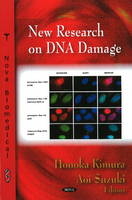
New Research on DNA Damage
Nova Science Publishers Inc (Verlag)
978-1-60456-581-2 (ISBN)
DNA damage, due to environmental factors and normal metabolic processes inside the cell, occurs at a rate of 1,000 to 1,000,000 molecular lesions per cell per day. While this constitutes only 0.000165% of the human genome's approximately 6 billion bases (3 billion base pairs), unrepaired lesions in critical genes (such as tumour suppresser genes) can impede a cell's ability to carry out its function and appreciably increase the likelihood of tumour formation. The vast majority of DNA damage affects the primary structure of the double helix; that is, the bases themselves are chemically modified. These modifications can in turn disrupt the molecules' regular helical structure by introducing non-native chemical bonds or bulky adducts that do not fit in the standard double helix. Unlike proteins and RNA, DNA usually lacks tertiary structure and therefore damage or disturbance does not occur at that level. DNA is, however, supercoiled and wound around "packaging" proteins called histones (in eukaryotes), and both superstructures are vulnerable to the effects of DNA damage. This book presents the latest research in the field.
Preface; Cancer and Aging as Consequences of Un-Repaired DNA Damage; Radiation-Induced DNA Damage Responses as Novel Targets in Cancer Treatments; BRIT1, A Novel DNA Damage Responsive Protein Dysfunctioned in Primary Microcephaly and Cancer; Polymorphisms in Genes Involved in DNA-Damage Processing and Their Effect on Cancer Risk; HTLV-I Tax Promotes Genomic Instability by Interfering with Repair of DNA Breaks; Genotoxicity and Biomonitoring: Micronuclei in Peripheral Blood and Epithelial Cells; Assays for the Quantitative Characterization of Genomic, Mitochondrial and Plasmid DNA; DNA Damage through Photo-Induced Electron Transfer and Photosensitized Generation of Reactive Oxygen Species; Consecutive Adenine Sequences Serve as Potential Targets in Photosensitized Oxidative DNA Damage; A Novel Methodology to Characterize DNA Damage Utilizing Phosphodiesterase I Function; Factors Governing the Recurrence and Breakpoint Distribution of Chromosomal Translocations in Human Tumors; Current Knowledge on Lead as an Inducer of Human DNA Damage; DNA Damage Signaling in Human Skin Cells Exposed to Hexavalent Chromium; Comparison of DNA Damage and the Expression of Repair Related Molecules, Including DNA Polymerase-ss, APE/ref-1, PCNA, and GADD45, in Human T and B Lymphocytes Exposed to Hydrogen Peroxide and Methyl Methanesulfonate; Mutational Hotspots of TP53 Gene Associated to DNA Damage; Mutation Detection in the TP53 Gene: Alternatives in Point Mutation Technologies; Index.
| Erscheint lt. Verlag | 1.4.2009 |
|---|---|
| Zusatzinfo | Illustrations |
| Verlagsort | New York |
| Sprache | englisch |
| Gewicht | 1034 g |
| Themenwelt | Informatik ► Weitere Themen ► Bioinformatik |
| Naturwissenschaften ► Biologie ► Genetik / Molekularbiologie | |
| ISBN-10 | 1-60456-581-0 / 1604565810 |
| ISBN-13 | 978-1-60456-581-2 / 9781604565812 |
| Zustand | Neuware |
| Haben Sie eine Frage zum Produkt? |
aus dem Bereich


